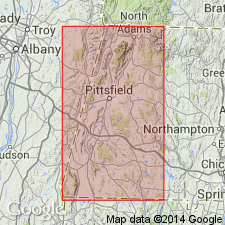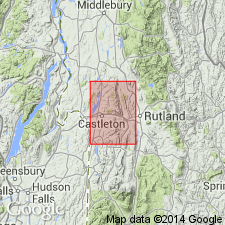
- Usage in publication:
-
- Berkshire schists
- Modifications:
-
- Named
- Dominant lithology:
-
- Schist
- AAPG geologic province:
-
- New England province
Dale, T.N., 1891, The Greylock synclinorium: American Geologist, v. 8, p. 1-7.
Summary:
Named the Berkshire schists for its prevalence in Berkshire Co., MA. In character, it is similar to the Greylock schists, but more frequently calcareous, especially toward the underlying Stockbridge limestone. Unit is overlain by the Bellows Pipe limestone in western MA. Thickness is 1000 to 2000 feet. The Berkshire is considered of Precambrian(?), Cambrian, and Ordovician age.
Source: GNU records (USGS DDS-6; Reston GNULEX).

- Usage in publication:
-
- Berkshire schist
- Modifications:
-
- Not used
- AAPG geologic province:
-
- New England province
Summary:
Pg. 38-40. Dale's Berkshire schist of probable Cambrian and Ordovician age is locally abandoned in Castleton quadrangle, Vermont, where name is replaced with Hortonville slate (Middle Ordovician) and some of the phyllites of Mendon series (pre-Cambrian?). Remainder of Berkshire, south of Castleton River, mapped as pre-Cambrian or Lower Cambrian (?) Nassau formation (Taconic sequence).
Source: Publication; US geologic names lexicon (USGS Bull. 1200, p. 310).
For more information, please contact Nancy Stamm, Geologic Names Committee Secretary.
Asterisk (*) indicates published by U.S. Geological Survey authors.
"No current usage" (†) implies that a name has been abandoned or has fallen into disuse. Former usage and, if known, replacement name given in parentheses ( ).
Slash (/) indicates name conflicts with nomenclatural guidelines (CSN, 1933; ACSN, 1961, 1970; NACSN, 1983, 2005, 2021). May be explained within brackets ([ ]).

